- 1G. B. Pant National Institute of Himalayan Environment, Almora, India
- 2Department of Ecology and Evolution, University of Chicago, Chicago, IL, United States
Global mountains, including the Himalaya, are highly vulnerable ecosystems, especially given climate and land-use changes. Here, we compile the literature on Himalayan biodiversity in order to assess spatial and taxonomic trends in research during the past 200 years. We identified 35,316 research outputs, including 28,120 journal articles, 3,725 doctoral theses, and 3,471 books. Nepal contributes the largest volume of published literature, followed by west Himalayan Indian states, with relatively few studies on the most biodiverse region lying to the east of Nepal. Publications on Himalayan biodiversity research have increased annually, especially after 1970, with an acceleration since 2000. Among the major taxonomic groups, the largest number of publications is on seed plants (angiosperms), followed by invertebrates (especially arthropods) and vertebrates. Some groups of organisms, notably fungi, bacteria, algae, bryophytes, pteridophytes, etc., are clearly understudied. Among various research disciplines, ecology is the most dominant field followed by agriculture, ethnobiology, and paleontology. Some newer disciplines, including molecular biology and climate change, have contributed to the growth in the number of papers appearing during the last two decades. Despite an encouraging and rapid increase in research papers during this century, they are largely in low-impact-factor journals, likely to be subject to poor peer review, and many doctoral theses remain unpublished. The Government of India's development initiative emphasizes the importance of research in the Himalaya, which can be enhanced by improved quality of peer review and local journals registering in global indexing services.
Introduction
The Himalaya represents the highest mountain system on earth. Extending more than 2,400 km in length, the Himalaya span a tremendous variation in climatic conditions from subtropical to boreal (Singh and Singh, 1987; Rawal et al., 2018; White et al., 2019). It forms the longest bioclimatic gradient in the world with vascular plants found from 60 to 6,400 m above sea level (Grytnes and Vetaas, 2002). The mountain range is situated at the confluence of four zoogeographic realms (Holt et al., 2013; White et al., 2019; the Palearctic, Saharo-Arabian, Sino-Japanese, and Oriental). Climatic variation associated with a wide range of habitats, colonized by fauna and flora from different realms, has resulted in a biodiversity hot spot of global importance (Myers et al., 2000).
Research and exploration of the Himalayan biodiversity dates back nearly 200 years. In 1808, J.W. Hooker published the first recorded publication on Himalayan species on the mosses of Nepal (Hooker, 1808). Much documentation took place in the nineteenth century. J.D. Hooker documented plants and published the work as The Flora of British India in seven volumes (Hooker, 1875). Similarly, Blanford conducted extensive research on animals and published The Fauna of British India series, also in seven volumes (Blanford, 1832). Nests and eggs of Indian birds were described in detail by Hume and Oates (1889), and systematic descriptions of the birds of the Indian subcontinent were published by Baker (1922). These basic descriptions have evolved into a wide array of research disciplines, including ecology, ethnobiology, organismal biology, molecular biology, and conservation.
The region is subject to both heavy monsoon rains and periodic earthquakes, making it prone to natural disasters (Vaidya et al., 2019), which has been exacerbated by recent anthropogenic pressures, especially deforestation and land-use changes (Pandit et al., 2014; Paudel et al., 2018). New approaches are required to restore the balance between economic interest in exploitation and ecological imperatives in conservation. The Government of India's think tank for development (NITI Aayog; National Institution for Transforming India) emphasizes five areas for achieving sustainable development in the Himalaya—one of which is the need for data for informed decision making (Anon, 2018). Such data can come from new research, but reviews of published works are essential to summarize current knowledge (Singh and Thadani, 2015). Some bibliometric analyses are available for small regions [e.g., the Kangchenjunga landscape (Kandel et al., 2016) and more recent publications from the east Himalaya (Basnet et al., 2019)], but a complete analysis for the Himalayan region is lacking. Here, we conduct a bibliometric analysis on biodiversity of the Himalaya, including books, research papers, and unpublished theses. We evaluate research efforts on biodiversity over time and space and ask how our findings can contribute to current and future policy.
Materials and Methods
Literature published in the English language was searched from the period of 1808, the oldest published record we found, up to 2018, irrespective of the number of citations. We used widely employed methods of bibliometric analysis (Kalantari et al., 2017; Bogers et al., 2018; Basnet et al., 2019; Le et al., 2019; Zhang et al., 2019). We followed the Preferred Reporting Items for Systematic Reviews and Meta-analyses (PRISMA; Moher et al., 2009; Figure 1) in order to identify published literature on Himalayan biodiversity during the last 200 years. We used eight standard databases, namely Web of Science (https://login.webofknowledge.com/), Scopus (www.scopus.com), SpringerLink (www.link.springer.com), JStor (www.jstor.org), Microsoft Academic (www.academic.microsoft.com), PubMed (https://pubmed.ncbi.nlm.nih.gov/), WorldCat (www.worldcat.org), and USDA-Agricola (https://agricola.nal.usda.gov), to systematically identify peer-reviewed journal articles, books, and theses on Himalayan biodiversity. In addition, we used Sodh Ganga (https://shodhganga.inflibnet.ac.in), which is a comprehensive database for doctoral theses from Indian Universities. Our survey spanned the Himalaya and the northeast Indian states (i.e., 11 Indian states, Nepal and Bhutan, Figure 2). We used the “OR” Boolean operator connecting prominent geographic regions and searched the title field only in the selected disciplines. We used the combination of the following keywords in our searches, adapted to the style of each search engine: “Himalaya” OR “Himalayas” OR “Kashmir” OR “Jammu” OR “Ladakh” OR “Himachal Pradesh” OR “Uttarakhand” OR “Kumaon” OR “Garhwal” OR “Nepal” OR “Sikkim” OR “Darjeeling” OR “Bhutan” OR “Arunachal Pradesh” OR “Assam” OR “Manipur” OR “Meghalaya” OR “Mizoram” OR “Nagaland” OR “Tripura.” The title of each record was screened, and the record was excluded from the review if it did not relate to any geographic region of the Himalaya. Abstracts of all records were then read and included if they were related to the field of biodiversity. With this search strategy, we must have missed some relevant studies, but the approach nevertheless resulted in a large database that enabled us to identify trends.
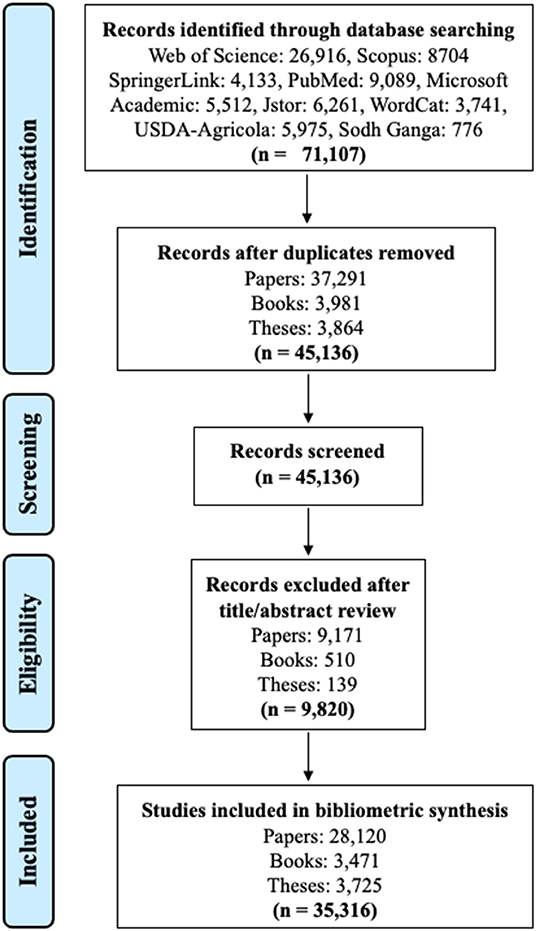
Figure 1. PRISMA flow diagram of the systematic literature review on the biodiversity of the Himalaya 1808–2018.
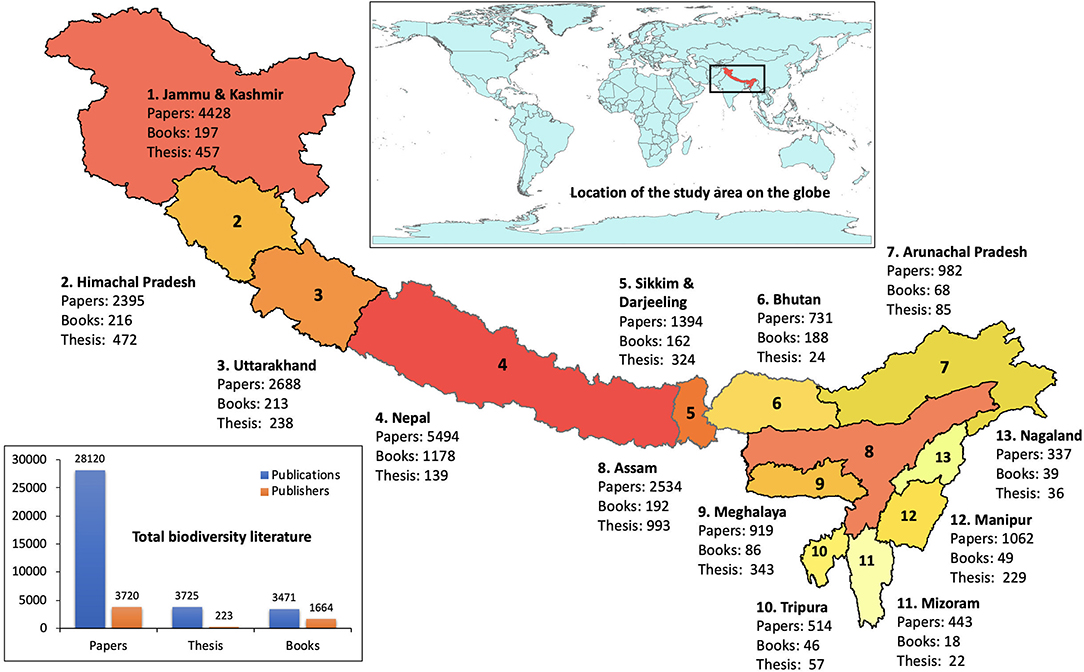
Figure 2. The study region (i.e., 11 Indian Himalayan and northeastern states, Nepal, and Bhutan) exhibiting the number of research publications identified on biodiversity from 1808 to 2018. The upper panel shows the location of the study region on the globe, and the lower panel shows totals of journal articles, theses, and books with the respective publishers, including journals, universities, and book publishers.
For each publication, we retrieved the following information: journal name, authors, title, year of publication, publisher, sampling area, and studied species/assemblages. Based on the information available in the title, keywords, and abstracts, we classified the articles into the following research disciplines: agriculture, biodiversity conservation, climate change, dendrochronology, ecology, ethnobiology, molecular biology, organismal biology, paleontology, pathology, palynology, and taxonomy. Ecology appeared most frequently, so we classified this topic into the following subdisciplines: behavioral ecology, community ecology, diversity and distribution, ecological interaction, forest ecology, population ecology, and others. Finally, for each publication, we identified the taxonomic group of study as virus, bacteria, protozoa, algae, fungi, lichens, bryophytes, pteridophytes, seed plants, invertebrates, vertebrates, and fossils. Vertebrates were further classified as mammals, fishes, birds, reptiles, and amphibians. Similarly, invertebrates were further classified as arthropods, nematodes, platyhelminths, mollusks, annelids, and rotifers, respectively.
Numbers in each of the three categories of literature, i.e., journal articles, doctoral theses, and books, were analyzed temporally from 1808 to 2018, spatially across the 11 Indian Himalayan states, Nepal and Bhutan, and across taxonomic groups. In order to evaluate spatial and temporal patterns in research quality, we asked which journals were indexed in the Science Citation Index (SCI). These journals are assessed through a rigorous selection process, thus providing high-quality, peer-reviewed research. Within the indexed journals, we also extracted the impact factor from the Journal Citation Reports (2019) published by Clarivate Analytics. The impact factor is based on average citations and, hence, expected to correlate with research quality.
Results
We identified 28,120 journal articles, 3,725 doctoral theses, and 3,471 books published on Himalayan biodiversity.
Research Topics
Ecology is the dominant field of research in the Himalaya, representing about 40% of the journal articles, 46% of theses, and 48% of books (Figure 3A; Supplementary Figure 1). Within the broad discipline of ecology, almost two thirds of the articles pertain to diversity and distributions with subsidiary contributions from community ecology and forest ecology (Supplementary Figure 2). Subsidiary fields of research vary across outlets: for journal articles, agriculture, taxonomy, and molecular biology; for theses, molecular and organismic biology; and for books, conservation and ethnobiology (Figure 3A). When comparing kingdoms, most publications are on Animalia (43%) and Plantae (36%) followed by fungi (4%) and bacteria (3%). Other taxonomic groups, such as algae, bryophytes, and pteridophytes, constitute <1% each of the total studies, and the remainder are general articles, e.g., on forestry (Figure 3B). Among the Animalia, invertebrates (23%) outnumber vertebrates (20%). Of the vertebrates, mammals constitute 27% of the studies, followed by fishes (22%)—both surprisingly exceeding studies on birds (20%) (Supplementary Figure 3).
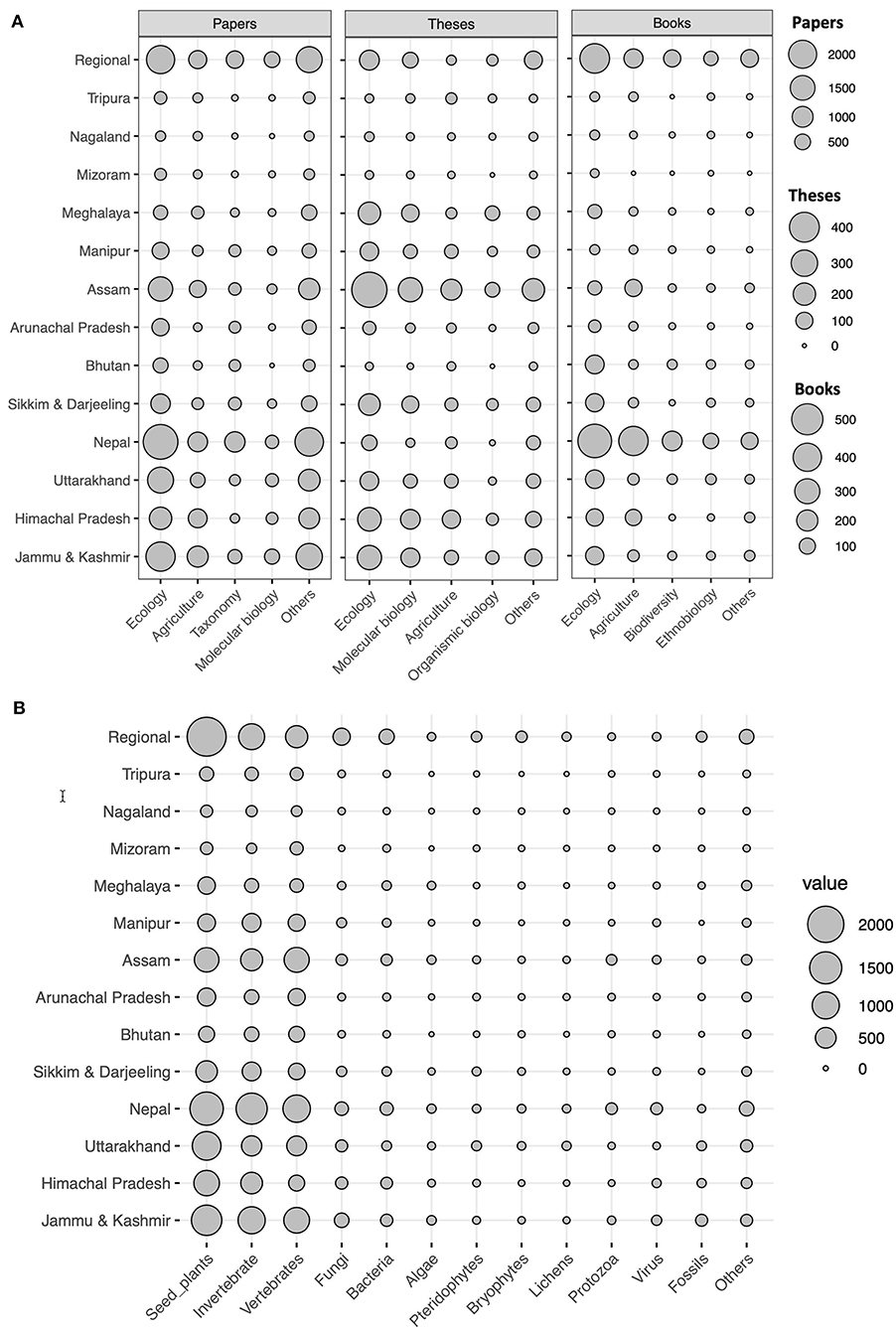
Figure 3. Spatial distribution of the literature across the region for (A) published journal articles, theses, and books in major research disciplines and (B) taxonomic groups.
Spatial Distribution
Among journal articles, studies that combine two or more of our predefined regions, including those that span the whole Himalaya, comprise 15% of the total. Among the rest, most articles pertain to Nepal (20% of the total) followed by Jammu and Kashmir, Uttarakhand, Assam, and Himachal Pradesh (Figure 1). The pattern is similar for books: 8% span more than one region, Nepal contributes 34%, and the same four states take up the next positions. Doctoral theses most commonly came from Assam (25%) followed by Himachal Pradesh, Jammu and Kashmir, Meghalaya, and Uttarakhand. It is notable that Bhutan, Arunachal Pradesh, and northeastern Indian states beyond Assam are very poorly represented.
Temporal Trends
The number of annual publications on Himalayan biodiversity continues to increase with an apparent acceleration around the year 2000 (Figure 4A). The number of articles in SCI-indexed journals has also increased, and higher impact factor journals form a higher fraction toward the present, especially since 2010 (Figure 4B). Studies in ecology show constant temporal growth in the case of research papers and theses, but more books were published during the decade preceding 2000 than in subsequent decades (Figures 4B–D). Although, as a whole, we observe continuous growth since 1970, states differ somewhat in their temporal trends. Before 1970, we record no articles at all from some states, including Arunachal Pradesh. Research from Meghalaya and Jammu and Kashmir appears to have lapsed in the late 1990's (Figure 5).
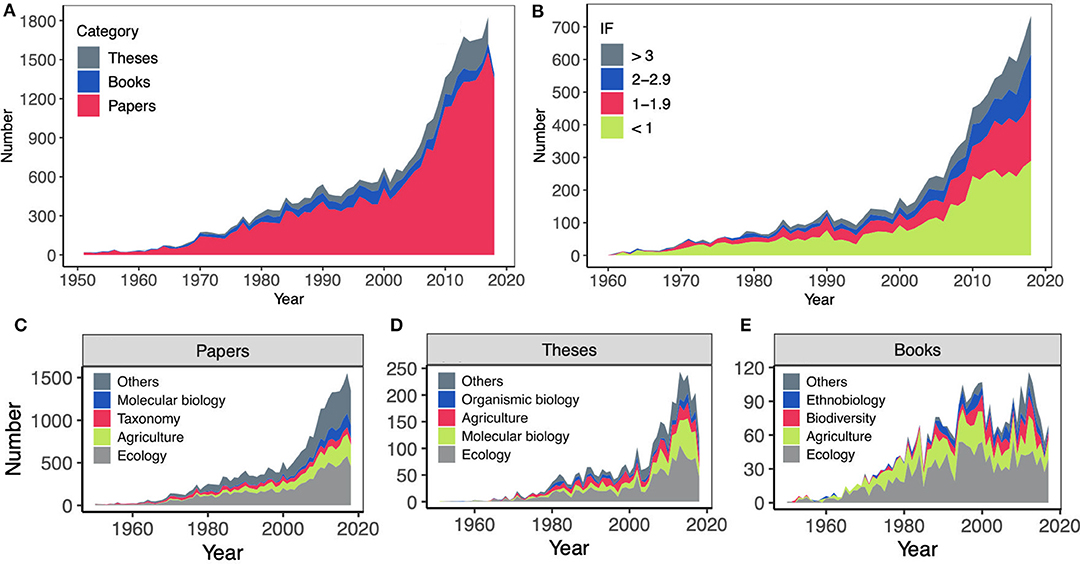
Figure 4. Temporal trend of publications from 1950 to 2018. (A) Number of papers, theses, and books published annually. (B) Number of papers published in four impact-factor categories. (C–E) Number of journal articles, theses, and books published under major research disciplines.
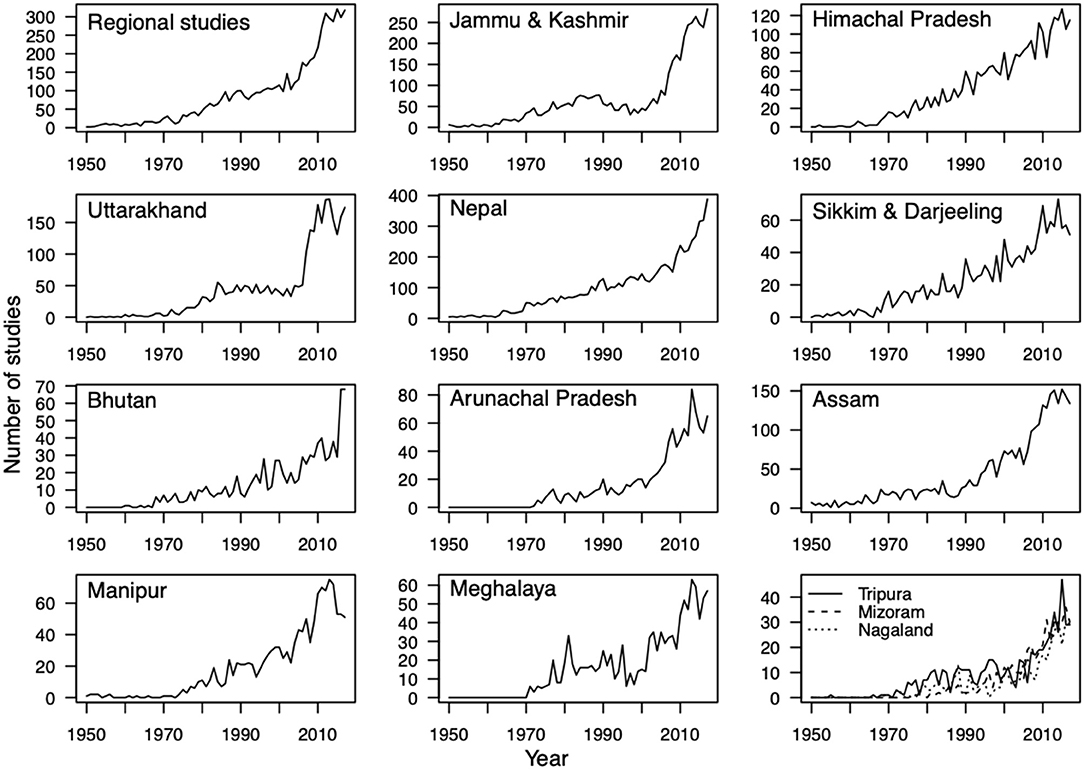
Figure 5. Temporal tends (1950–2018) of publications within the 11 Indian Himalayan and northeastern states, Nepal, and Bhutan.
Outlets
In terms of research quality, about two thirds of the papers were published in journals that are not covered in the SCI. Among those that are, 44% are in journals with an impact factor of <1.0 with only 13% above an impact factor of 4.0. Among the top publishing agencies on Himalayan biodiversity, the Journal of the Bombay National History Society and Current Science have published more than 700 articles, The Indian Forester more than 600 articles, and the Indian Journal of Agricultural Sciences, Journal of Economic and Taxonomic Botany, and Indian Journal of Animal Sciences between 300 and 400 articles (Supplementary Figure 5). Among these journals, only Current Science (impact factor: 0.72) is indexed in the SCI. A regional breakdown is shown in Supplementary Figure 4. Studies at the gross regional scale and from Nepal contribute the highest number of research articles in journals in the SCI (Supplementary Figure 4).
Gauhati University, Assam, has produced more than twice the number of theses than the next highest: North-Eastern Hill University, also in Assam (Supplementary Figure 6). The International Center for Integrated Mountain Development (Nepal) has published the most books, followed by Bishen Singh Mahendra Pal Singh Publishers (India) (Supplementary Figure 7).
Discussion
It is thought that between 15 and 85% of eukaryotes remain to be named (Pimm et al., 2014). Further, the distribution of many named species are poorly mapped (Kier et al., 2005), and 23% of all named plants remain to be taxonomically resolved because of potential synonyms (The Plant List, 2013). This is particularly true of the Himalaya, where many species have been little studied, new ones are continually being discovered (Athreya, 2006; Banik and Sanjappa, 2007; Thompson, 2009; Kamei et al., 2012; Basnet et al., 2019), and 1,134 out of 10,503 reported plant species (11%) remain taxonomically unresolved (Rana and Rawat, 2017). Consequently, it is apparent that much remains to be learned about Himalayan biodiversity, but what we do know has not been previously compiled. We focused on understanding what studies have been conducted; which species groups, disciplines, and geographic regions remain to be explored; trends over time; and their policy implications. Our assessment comes with caveats, including the restricted number of search words, i.e., state and country name, and we examined titles only. Hence, the bibliography is necessarily incomplete given our search methods but, nevertheless, resulted in more than 28,000 published journal articles, more than 3,700 doctoral theses, and nearly 3,500 books, implying that much information on Himalayan biodiversity is already available. The large number of publications highlights the need for a bibliographic database so that researchers can locate papers relevant to their own studies. We will maintain the database and encourage others to add works to it derived from alternative search methods and their own experience.
Globally, the annual growth rate of research publications in the fields of ecology, biodiversity conservation, and plant science has also shown a continuous increase (Liu et al., 2011). Biodiversity research gained high momentum in the 1990's, attributed to the 1992 Rio Earth Summit when nations signed the United Nations Convention on Biological Diversity (Liu et al., 2011). The increase in the Himalayan region came about a decade after this (Figure 4), suggesting a mismatch of implementation in global and local research policies. Overall, however, we find an encouragingly rapid increase in the number of publications with an acceleration after 1970 and again after 2000. Coverage of different regions has not increased uniformly. No papers before 1970 were published for several states in northeast India, and they contain the maximum biodiversity for many groups (Behera et al., 2002; Mishra et al., 2006; Price et al., 2011; Banerjee et al., 2019; Rana et al., 2019). One possibility is that our searches missed papers, for example, because eastern states have been renamed (Arunachal Pradesh was known as North-East Frontier Agency before 1972), but even more recent publications from the west Himalaya continue to outnumber those from the east (Figure 5). Other discordances from the overall pattern include the rise in papers that study molecular biology (only since 2000); dips in the late 1990's in Jammu and Kashmir and Meghalaya, perhaps reflecting unrest in those regions; and a relative flatlining of paleontology papers.
Despite the large number of publications, we confirm that the world's highest mountain system, the Himalaya, is data- and information-deficient (Kier et al., 2005; Singh and Thadani, 2015) if only because northeast India is covered so poorly. Some taxonomic groups have clearly received less study in proportion to their species richness, including bacteria, fungi, algae, bryophytes, and pteridophytes. Similar results have been reported from the far eastern Himalayan landscape, where Basnet et al. (2019) lists more papers on mammals than on arthropods or angiosperms. Disparities also apply globally, as more publications are focused on faunas than floras (Stork and Astrin, 2014).
The number of published journal articles and books is much less in the northeastern states of India than from Nepal and the Indian western Himalayan states. This contrasts with the number of doctoral theses reported from universities in the eastern Himalayan region, particularly from Gauhati University (Assam) and North-eastern Hill University (Meghalaya). Our finding implies researchers from northeastern Indian states are reticent in publishing their results. Consequently, much information on the biodiversity of the northeastern states of India remains hidden. Further, although there is an encouraging temporal increase in the number of publications, many are published in low-impact journals, probably subject to weak review. For example, all the top 20 journals publishing research on the Himalaya are regional and mostly located in India. Only three among these, i.e., Current Science, Tropical Ecology, and Zootaxa, are indexed in SCI, and all three have an impact factor of less than one. Overall ~37% of journal articles published on Himalayan biodiversity are from SCI-indexed journals, and all besides Current Science and Tropical Ecology are published outside India. Across the sciences more generally, India has almost quadrupled its scholarly output since 2000, but impact is low (Van Noorden, 2015), similar to the Himalayan pattern. In terms of research impact more generally, India has been among the least cited countries in the world (King, 2004).
We attribute the large number of journal articles and books from Nepal to more work by foreign researchers there than elsewhere. Studies from Nepal, along with Jammu and Kashmir, also show the highest number of journal articles listed in SCI. Indian journals might review their publishing strategies, including use of global indexing services (e.g., SCI and Scopus). In this way, journals can take the lead in encouraging scientists to improve the quality of their research and its application. Also, the Government of India might consider launching special drives/schemes for northeastern states by motivating researchers in west Himalayan states to work—and publish—in collaboration with researchers in the northeast.
The data underlying this paper is available as Supplementary Material online. Going forward, we intend to extract information available in this bibliography on a species-by-species level. For example, information on seed plants will build on the already compiled data set on species distributions (Rana and Rawat, 2017; Rana et al., 2019), which will be refined by extracting information from 8,000 published journal articles and 1,500 doctoral theses. Information on various aspects of the species, including range, population status, conservation status, functional traits, economic values, and biochemical and molecular composition, will be compiled. Such data can be used for better integration of empirical research, thereby directly embedding biodiversity knowledge into policies, strategies, and practices for solving pressing problems of conservation (Redford et al., 2015; Rillig et al., 2015). Sustainability goals can only be achieved through improved knowledge on social and ecological systems, effectiveness of governance systems, and the influence of institutions on the social distribution of ecosystem services (Sutherland et al., 2009; Mastrángelo et al., 2019). Our database is a step toward the synthesis of available biodiversity data, which can be integrated with socio-cultural information in order to address issues of biodiversity conservation and sustainable development in the Himalaya.
Conclusion
The global importance of the Himalaya is not reflected in our knowledge of its biodiversity. Recently, the number of papers on the Himalaya has rapidly increased, but most are published in poorly peer-reviewed, low-impact journals. We conclude that (1) journals should register in global indexing services and initiate a rigorous peer-review process; (2) regional research institutes and universities might similarly adopt an approach toward publishing in higher impact journals; (3) collaborative research efforts might redress the unevenness of coverage across the Himalaya; and (4) given published policy priorities (Anon, 2018), government initiatives should be used to encourage (1–3). Research gaps are now identified, enabling regional-level plans to address the current challenges of biodiversity conservation and its sustainable utilization for human welfare.
Data Availability Statement
The original contributions presented in the study are included in the article/Supplementary Materials, further inquiries can be directed to the corresponding author/s.
Author Contributions
SR and RR conceived the idea and designed the study. SR and BD compiled the database. SR wrote the manuscript. All authors contributed to content and editing of the manuscript.
Funding
Partial funding for this study was made available through the Mountain Division of NIHE, National Mission for Sustaining the Himalayan Ecosystem (NMSHE), Task Force-3 (Grant No. DST/SPLICE/ CCP/NMSHE/TF/GBPIHED/2014), and National Mission on Himalayan Studies (Grant No. NMHS/MG/2017-18/17).
Conflict of Interest
The authors declare that the research was conducted in the absence of any commercial or financial relationships that could be construed as a potential conflict of interest.
Acknowledgments
We thank G.B. Pant National Institute of Himalayan Environment (NIHE), for support. The assistance received from researchers at the Center for Biodiversity Conservation and Management, NIHE are gratefully acknowledged.
Supplementary Material
The Supplementary Material for this article can be found online at: https://www.frontiersin.org/articles/10.3389/fevo.2020.603422/full#supplementary-material
Supplementary Figure 1. Total number of journal articles published on various research disciplines from 11 Indian Himalayan and northeastern states, Nepal, and Bhutan and their temporal trend during 1950–2018.
Supplementary Figure 2. Total number of journal articles published on various subthemes of ecology from 11 Indian Himalayan and northeastern states, Nepal, and Bhutan and their temporal trend during 1950–2018.
Supplementary Figure 3. Spatial distribution of published journal articles on various animal taxa across the target region.
Supplementary Figure 4. Distribution of articles published on biodiversity from various regions of the Himalaya in various SCI-indexed journals under different impact-factor categories.
Supplementary Figure 5. Top 20 publishing journals on Himalayan biodiversity.
Supplementary Figure 6. Top 10 publishing universities on Himalayan biodiversity.
Supplementary Figure 7. Top 10 publishing agencies of books on Himalayan biodiversity.
References
Anon (2018). A Summary Report: Contributing to Sustainable Development in the Indian Himalayan Region. NITI Ayog, Sansad Marg, New Delhi. Available online at: https://niti.gov.in/writereaddata/files/document_publication/doc6.pdf
Athreya, R. (2006). A new species of Liocichla (Aves: Timaliidae) from Eaglenest Wildlife Sanctuary, Arunachal Pradesh, India. Indian Birds 2, 82–94.
Baker, E. C. S. (1922). The Fauna of British India Including Ceylon And Burma Birds. Vol. I-VIII. London: Taylor & Francis. doi: 10.5962/bhl.title.8685
Banerjee, A., Chakraborty, P., and Bandopadhyay, R. (2019). Urgent conservation needs in the Sikkim Himalaya biodiversity hotspot. Biodiversity 20, 88–97. doi: 10.1080/14888386.2019.1656547
Banik, D., and Sanjappa, M. (2007). Three new species of Agapetes (Ericaceae) from India. Edinburgh J. Botany 64, 335–342. doi: 10.1017/S0960428607004611
Basnet, D., Kandel, P., Chettri, N., Yang, Y., Lodhi, M. S., Htun, N. Z., et al. (2019). Biodiversity research trends and gaps from the confluence of three global biodiversity hotspots in the far-eastern Himalaya. Int. J. Ecol. 2019, 1–14. doi: 10.1155/2019/1323419
Behera, M. D., Kushwaha, S. P. S., and Roy, P. S. (2002). High plant endemism in an Indian hotspot—eastern Himalaya. Biodivers. Conserv. 11, 669–682. doi: 10.1023/A:1015596309833
Blanford, W. T. (1832). The Fauna of British India, Including Ceylon and Burma. Vol. I-VII. London: Taylor & Francis.
Bogers, M., Chesbrough, H., and Moedas, C. (2018). Open innovation: research, practices, and policies. Calif. Manage. Rev. 60, 5–16. doi: 10.1177/0008125617745086
Grytnes, J. A., and Vetaas, O. R. (2002). Species richness and altitude: a comparison between null models and interpolated plant species richness along the Himalayan altitudinal gradient, Nepal. Am. Nat. 159, 294–304. doi: 10.1086/338542
Holt, B. G., Lessard, J.-P., Borregaard, M. K., Fritz, S. A., Araújo, M. B., Dimitrov, D., et al. (2013). An update of wallace's zoogeographic regions of the world. Science 339, 74–78. doi: 10.1126/science.1228282
Hooker, J. D. (1875). The Flora of British India. Vol. I-VII. London: L. Reeve. doi: 10.5962/bhl.title.54393
Hooker, W. J. (1808). XXIV. Musci Nepalenses; or descriptions of several new Mosses from Nepal. Trans. Linnean Soc. London 9, 307–322. doi: 10.1111/j.1096-3642.1818.tb00349.x
Hume, A. O., and Oates, E. W. (1889). The Nests and Eggs of Indian Birds. Vol. I-III. London: R. H. Porter. doi: 10.5962/bhl.title.55109
Kalantari, A., Kamsin, A., Kamaruddin, H. S., Ale Ebrahim, N., Gani, A., Ebrahimi, A., et al. (2017). A bibliometric approach to tracking big data research trends. J. Big Data 4:30. doi: 10.1186/s40537-017-0088-1
Kamei, R. G., Mauro, D. S., Gower, D. J., Van Bocxlaer, I., Sherratt, E., Thomas, A., et al. (2012). Discovery of a new family of amphibians from northeast India with ancient links to Africa. Proc. Biol. Sci. 279, 2396–2401. doi: 10.1098/rspb.2012.0150
Kandel, P., Gurung, J., Chettri, N., Ning, W., and Sharma, E. (2016). Biodiversity research trends and gap analysis from a transboundary landscape, Eastern Himalayas. J. Asia-Pacific Biodiv. 9, 1–10. doi: 10.1016/j.japb.2015.11.002
Kier, G., Mutke, J., Dinerstein, E., Ricketts, T. H., Küper, W., Kreft, H., et al. (2005). Global patterns of plant diversity and floristic knowledge. J. Biogeogr. 32, 1107–1116. doi: 10.1111/j.1365-2699.2005.01272.x
Le, H. T. T., Dao, Q. T. M., Pham, V.-C., and Tran, D. T. (2019). Global trend of open innovation research: a bibliometric analysis. Cogent. Bus. Manag. 6:1633808. doi: 10.1080/23311975.2019.1633808
Liu, X., Zhang, L., and Hong, S. (2011). Global biodiversity research during 1900–2009: a bibliometric analysis. Biodivers. Conserv. 20, 807–826. doi: 10.1007/s10531-010-9981-z
Mastrángelo, M. E., Pérez-Harguindeguy, N., Enrico, L., Bennett, E., Lavorel, S., Cumming, G. S., et al. (2019). Key knowledge gaps to achieve global sustainability goals. Nat. Sustain. 2, 1115–1121. doi: 10.1038/s41893-019-0412-1
Mishra, C., Madhusudan, M. D., and Datta, A. (2006). Mammals of the high altitudes of western Arunachal Pradesh, eastern Himalaya: an assessment of threats and conservation needs. Oryx 40, 29–35. doi: 10.1017/S0030605306000032
Moher, D., Liberati, A., Tetzlaff, J., Altman, D. G., and Group, T. P. (2009). Preferred reporting items for systematic reviews and meta-analyses: the PRISMA statement. PLoS Med. 6:e1000097. doi: 10.1371/journal.pmed.1000097
Myers, N., Mittermeler, R. A., Mittermeler, C. G., Da Fonseca, G. A. B., and Kent, J. (2000). Biodiversity hotspots for conservation priorities. Nature 403, 853–858. doi: 10.1038/35002501
Pandit, M. K., Manish, K., and Koh, L. P. (2014). Dancing on the roof of the world: ecological transformation of the Himalayan landscape. Bioscience 64, 980–992. doi: 10.1093/biosci/biu152
Paudel, P. K., Sipos, J., and Brodie, J. F. (2018). Threatened species richness along a Himalayan elevational gradient: quantifying the influences of human population density, range size, and geometric constraints. BMC Ecol. 18:6. doi: 10.1186/s12898-018-0162-3
Pimm, S. L., Jenkins, C. N., Abell, R., Brooks, T. M., Gittleman, J. L., Joppa, L. N., et al. (2014). The biodiversity of species and their rates of extinction, distribution, and protection. Science 344:1246752. doi: 10.1126/science.1246752
Price, T. D., Mohan, D., Tietze, D. T., Hooper, D. M., Orme, C. D. L., and Rasmussen, P. C. (2011). Determinants of northerly range limits along the Himalayan bird diversity gradient. Am. Nat. 178, S97–S108. doi: 10.1086/661926
Rana, S. K., Price, T. D., and Qian, H. (2019). Plant species richness across the Himalaya driven by evolutionary history and current climate. Ecosphere 10:e02945. doi: 10.1002/ecs2.2945
Rana, S. K., and Rawat, G. S. (2017). Database of Himalayan plants based on published floras during a century. Data 2:36. doi: 10.3390/data2040036
Rawal, R. S., Rawal, R., Rawat, B., Negi, V. S., and Pathak, R. (2018). Plant species diversity and rarity patterns along altitude range covering treeline ecotone in Uttarakhand: conservation implications. Trop. Ecol. 59, 225–239.
Redford, K. H., Huntley, B. J., Roe, D., Hammond, T., Zimsky, M., Lovejoy, T. E., et al. (2015). Mainstreaming biodiversity: conservation for the twenty-first century. Front. Ecol. Evol. 3:137. doi: 10.3389/fevo.2015.00137
Rillig, M. C., Kiessling, W., Borsch, T., Gessler, A., Greenwood, A. D., Hofer, H., et al. (2015). Biodiversity research: data without theory—theory without data. Front. Ecol. Evol. 3:20. doi: 10.3389/fevo.2015.00020
Singh, J. S., and Singh, S. P. (1987). Forest vegetation of the Himalaya. Botanical Rev. 53, 80–192. doi: 10.1007/BF02858183
Singh, S. P., and Thadani, R. (2015). Complexities and controversies in Himalayan research: a call for collaboration and rigor for better data. Mt. Res. Dev. 35, 401–409. doi: 10.1659/MRD-JOURNAL-D-15-00045
Stork, H., and Astrin, J. J. (2014). Trends in biodiversity research—a bibliometric assessment. Open J. Ecol. 4, 720–726. doi: 10.4236/oje.2014.47033
Sutherland, W. J., Adams, W. M., Aronson, R. B., Aveling, R., Blackburn, T. M., Broad, S., et al. (2009). One hundred questions of importance to the conservation of global biological diversity. Conserv. Biol. 23, 557–567. doi: 10.1111/j.1523-1739.2009.01212.x
The Plant List (2013). Version 1.1. Published on the Internet. Available online at: http://www.theplantlist.org/ (accessed 1 August, 2020).
Thompson, C. (2009). New Species Discoveries: The Eastern Himalayas, Where Worlds Collide. New Delhi: World Wide Fund for Nature.
Vaidya, R. A., Shrestha, M. S., Nasab, N., Gurung, D. R., Kozo, N., Pradhan, N. S., et al. (2019). “Disaster risk reduction and building resilience in the Hindu Kush Himalaya,” in The Hindu Kush Himalaya Assessment: Mountains, Climate Change, Sustainability and People, eds P. Wester, A. Mishra, A. Mukherji, and A. B. Shrestha (Cham: Springer International Publishing), 389–419. doi: 10.1007/978-3-319-92288-1_11
White, A. E., Dey, K. K., Mohan, D., Stephens, M., and Price, T. D. (2019). Regional influences on community structure across the tropical-temperate divide. Nat. Commun. 10:e2646. doi: 10.1038/s41467-019-10253-6
Keywords: bibliometrics, biodiversity, conservation—governance, Himalaya, research quality
Citation: Rana SK, Rawal RS, Dangwal B, Bhatt ID and Price TD (2021) 200 Years of Research on Himalayan Biodiversity: Trends, Gaps, and Policy Implications. Front. Ecol. Evol. 8:603422. doi: 10.3389/fevo.2020.603422
Received: 06 September 2020; Accepted: 21 December 2020;
Published: 27 January 2021.
Edited by:
Umesh Srinivasan, Indian Institute of Science (IISc), IndiaReviewed by:
Kumar Manish, University of Delhi, IndiaJennifer Lesley Silcock, The University of Queensland, Australia
Copyright © 2021 Rana, Rawal, Dangwal, Bhatt and Price. This is an open-access article distributed under the terms of the Creative Commons Attribution License (CC BY). The use, distribution or reproduction in other forums is permitted, provided the original author(s) and the copyright owner(s) are credited and that the original publication in this journal is cited, in accordance with accepted academic practice. No use, distribution or reproduction is permitted which does not comply with these terms.
*Correspondence: Suresh K. Rana, ZW52c3VyZXNoMDlAZ21haWwuY29t
 Suresh K. Rana
Suresh K. Rana Ranbeer S. Rawal1
Ranbeer S. Rawal1 Bhawana Dangwal
Bhawana Dangwal Indra D. Bhatt
Indra D. Bhatt Trevor D. Price
Trevor D. Price